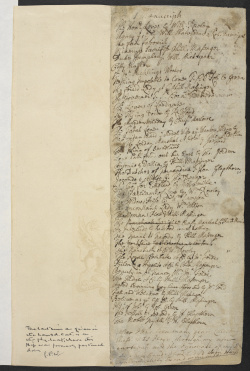Lovers of Ludgate, The
Historical Records
"The Lovers of Loodgate" is included in John Warburton's List (c.1682-1759) of play-manuscripts allegedly destroyed when his cook used them as paper linings for pies:

- (British Library, Lansdowne MS 807, fo.1r. Reproduced by permission of the British Library. Click image to view full page; click here for more information on Warburton's list)
Many of the plays on Warburton's list are mentioned in other sources, but this is not the case with "The Lovers of Ludgate".
Theatrical Provenance
Unknown, but presumably pre-1642, like the rest of the datable plays on Warburton's list.
Probable Genre(s)
City play; love play. Prison play?
Possible Narrative and Dramatic Sources or Analogues
None known (but see "For What It's Worth")
References to the Play
None known
Critical Commentary
None hitherto. Undatable and untraceable, this play has remained (I believe) entirely undiscussed beyond a bare listing. Bentley (5.1366) catalogues it, and puts it in the context of Warburton's list as a whole.
For transcription and discussion of the status of the document in which it is found, see this page: Warburton's List.
Ludgate is a street of the City of London, best known for its eponymous gate, controlling the Western entrance to the city. In Elizabethan times, the gatehouse also served as a prison. It is not clear whether it is the region, or the prison, that featured in this play. The nineteenth-century historian Walter Thornbury gives a short history of the area, conveniently available online. E.H. Sugden gives a list of references to Ludgate in Renaissance drama, the bulk of which are to its role as a debtor's prison.
For What It's Worth
Sugden and Thornbury both record one, and only one, love story associated with Ludgate. This is that of Stephen Forster, fishmonger and fifteenth-century Lord Mayor of London, and Dame Agnes. Early in his career, the story goes, Forster was imprisoned for debt in Ludgate, and, while at the begging grate, one day met a rich widow. Taken with him, she paid for his release; he worked hard and came good; married her; and ended up as Lord Mayor. On his death, Dame Agnes became a major benefactor to Ludgate, commemorated in a tablet in the chapel:
- Devout souls that pass this way,
- For Stephen Forster, late Lord Mayor, heartily pray,
- And Dame Agnes, his spouse, to God consecrate,
- That of pity this house made for Londoners in Lud Gate;
- So that for lodging and water prisoners here nought pay,
- As their keepers shall all answer at dreadful doomsday.
The inscription is included in Stow. As Thornbury and Sugden further note, there was at least one dramatization of the story of Stephen and Agnes on the early modern stage. William Rowley’s A New Wonder, a Woman Never Vexed (printed 1631) features it, including several scenes set in the Ludgate prison itself.
This story might be worth consideration as a candidate to have provided the plot of The Lovers of Ludgate.
Works Cited
Sugden, Edward H., A Topographical Dictionary to the Works of Shakespeare and his Fellow Dramatists. Manchester: Manchester University Press, 1925.
Thornbury, Walter. 'Ludgate Hill', Old and New London: Volume 1 (1878), pp. 220-233. URL: http://www.british-history.ac.uk/report.aspx?compid=45038 Date accessed: 30 January 2011.
Page created by Matthew Steggle, Sheffield Hallam University. Last edited 11 January 2013.